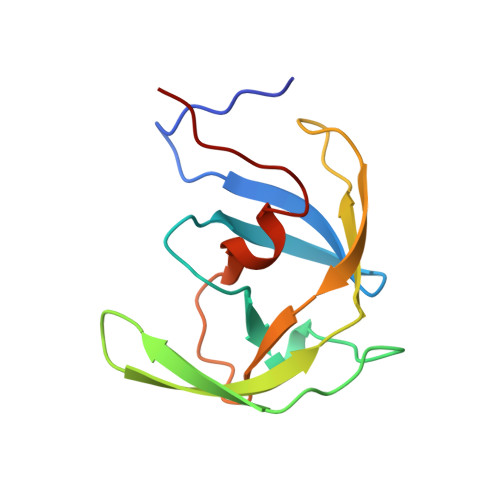Structural studies of FIV and HIV-1 proteases complexed with an efficient inhibitor of FIV protease
Li, M., Morris, G.M., Lee, T., Laco, G.S., Wong, C.H., Olson, A.J., Elder, J.H., Wlodawer, A., Gustchina, A.(2000) Proteins 38: 29-40
- PubMed: 10651036
- DOI: https://doi.org/10.1002/(sici)1097-0134(20000101)38:1<29::aid-prot4>3.0.co;2-n
- Primary Citation of Related Structures:
1B11, 3TLH, 5FIV, 6FIV - PubMed Abstract:
Three forms of feline immunodeficiency virus protease (FIV PR), the wild type (wt) and two single point mutants, V59I and Q99V, as well as human immunodeficiency virus type 1 protease (HIV-1 PR), were cocrystallized with the C2-symmetric inhibitor, TL-3. The mutants of FIV PR were designed to replace residues involved in enzyme-ligand interactions by the corresponding HIV-1 PR residues at the structurally equivalent position. TL-3 shows decreased (improved) inhibition constants with these FIV PR mutants relative to wt FIV PR. Despite similar modes of binding of the inhibitor to all PRs (from P3 to P3'), small differences are evident in the conformation of the Phe side chains of TL-3 at the P1 and P1' positions in the complexes with the mutated FIV PRs. The differences mimick the observed binding of TL-3 in HIV-1 PR and correlate with a significant improvement in the inhibition constants of TL-3 with the two mutant FIV PRs. Large differences between the HIV-1 and FIV PR complexes are evident in the binding modes of the carboxybenzyl groups of TL-3 at P4 and P4'. In HIV-1 PR:TL-3, these groups bind over the flap region, whereas in the FIV PR complexes, the rings are located along the major axis of the active site. A significant difference in the location of the flaps in this region of the HIV-1 and FIV PRs correlates with the observed conformational changes in the binding mode of the peptidomimetic inhibitor at the P4 and P4' positions. These findings provide a structural explanation of the observed Ki values for TL-3 with the different PRs and will further assist in the development of improved inhibitors.
Organizational Affiliation:
Macromolecular Structure Laboratory, ABL-Basic Research Program, NCI-Frederick Cancer Research and Development Center, Maryland 21702, USA.
















